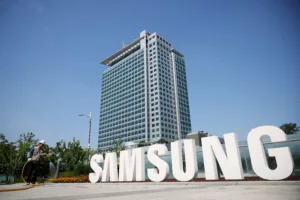Samsung Electronics announced its intention to persist with production reductions in order to alleviate an oversupply of chips, with a focus on preparing for 2024. In that year, the company anticipates that the industry will pivot towards heightened investment and production of high-end chips for generative artificial intelligence.

An employee is seen tending to a flower bed adjacent to the Samsung Electronics logo during a media tour at Samsung Electronics’ headquarters in Suwon, South Korea, on June 13, 2023.
Samsung has scaled down its chip production throughout this year as a response to an unparalleled downturn in the industry. The company has also indicated its plans for further adjustments in production, particularly for NAND flash memory chips, as the market begins to rebound.
During an earnings call, Jaejune Kim, the Executive Vice President of Samsung’s memory business, revealed that the company has received purchase inquiries from server customers looking to secure components. This interest has grown as awareness spreads that the industry has reached its low point. Kim stated, “Considering the normalization of inventory levels, we expect the market to recover, particularly in PC and mobile memory.”
Samsung, the world’s largest memory chip and smartphone manufacturer, anticipates a surge in demand for DRAM chips, including high-bandwidth memory (HBM), in 2024. This surge is expected due to the proliferation of on-device AI functions.
Samsung faces competition in the field of memory chips for AI from companies like SK Hynix, which secured a leading position in HBM3 chips through its supply partnership with tech giant Nvidia (NVDA.O). Chip manufacturers are currently working on the development of the next-generation HBM3E chips for release in 2024.
Samsung has disclosed its plans to significantly expand its HBM chip production capacity, aiming to achieve an increase of 2.5 times or more in 2024 compared to this year.
Following these statements, Samsung’s shares were down by 0.3% around midday, while SK Hynix’s shares experienced a 1.9% decline. The benchmark index (.KS11) showed a 1.3% decrease.
The prospect of a recovery in NAND chips appears to be less certain since these chips are primarily associated with data storage and aren’t directly tied to AI demand. Nevertheless, analysts have noted that ongoing production reductions would accelerate the resurgence of traditional memory chips.
Analyst Ko Yeongmin from Daol Investment & Securities commented on the earnings call, highlighting the significance of Samsung’s indication that older legacy chips are also on the path to recovery. This insight is particularly noteworthy, given the challenges faced by the NAND market. Samsung’s mention of flexible production cuts was seen as a strategically sound move.
Samsung reported an operating profit of 2.4 trillion won ($1.78 billion) for the July-September period, marking a 78% decline compared to the previous year but a one-third improvement from the two preceding quarters. The revenue dipped by 12% to 67.4 trillion won.
In the memory chip sector, the losses decreased to 3.75 trillion won in the third quarter, in contrast to 4.36 trillion won in the second quarter.
The South Korean factory output increased for the second consecutive month in September, influenced by the rise in chip production, indicative of a rebound in chip demand.
Samsung’s mobile devices segment recorded a profit of 3.3 trillion won, slightly higher than the previous year, driven by strong sales of premium foldable smartphones.
Regarding mobile demand, Samsung anticipates stabilization in the upcoming year after experiencing a contraction in 2022-2023. The company aims for double-digit growth in flagship mobile product shipments and revenue growth surpassing market expansion.
Samsung also disclosed its plans to allocate a record 53.7 trillion won in capital expenditure this year, with a significant portion, 47.5 trillion won, allocated to the chip sector to prepare for anticipated long-term demand increases.
This substantial investment mirrors the dynamic shifts occurring in the chip industry, with a growing focus on AI and disruptions from major tech players shifting to in-house chip development. For instance, Apple announced its custom chips on Monday, illustrating this trend.
(Note: The currency conversion is based on an exchange rate of $1 = 1,346.5000 won.)
Reported by Joyce Lee and Heekyong Yang; Edited by Christopher Cushing and Miyoung Kim





